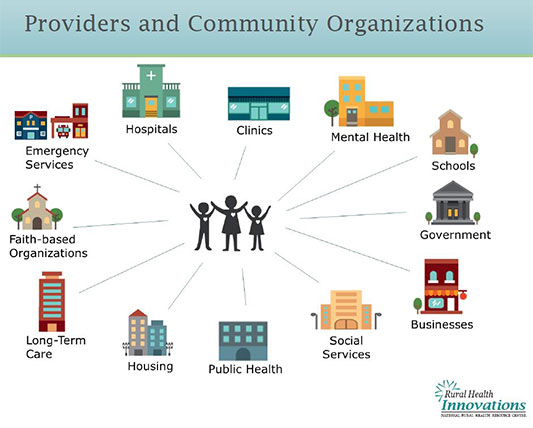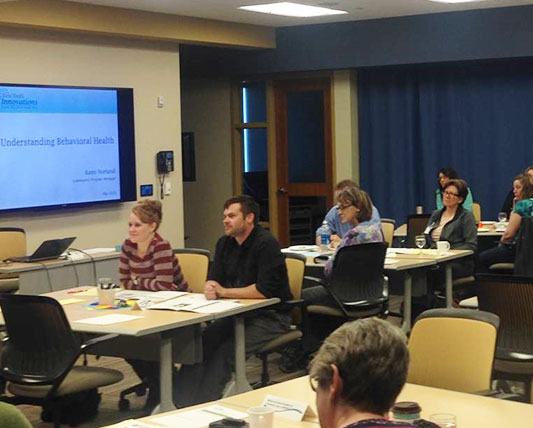The Minnesota Integrative Behavioral Health Program
- Need: Out of 79 Critical Access Hospitals (CAHs) surveyed in Minnesota in 2015, behavioral health was the most frequently cited service requested.
- Intervention: In response, Rural Health Innovations launched the Minnesota Integrative Behavioral Health Program. This initiative engaged representatives across all sectors in health integration between hospital, primary care, and community services.
- Results: Strategy sessions resulted in the creation of resource directories to improve care coordination, evaluation measurements to document results, and an overall better understanding of integrative care challenges.
Description
In Minnesota, over 800,000 individuals, or 1 in 5, experience some form of mental illness. Less than half will receive treatment due to a variety of reasons, including lack of access and stigma-related causes. Out of 79 Critical Access Hospitals (CAHs) surveyed in Minnesota in 2015, behavioral health was the most frequently cited service requested.
 In response, Rural
Health Innovations (RHI) launched the Minnesota Integrative
Behavioral Health (IBH) Program. Because everyone is
directly or indirectly impacted by mental illness,
engaging representatives across all sectors became
imperative to behavioral health integration among
hospital, primary care, and community services.
In response, Rural
Health Innovations (RHI) launched the Minnesota Integrative
Behavioral Health (IBH) Program. Because everyone is
directly or indirectly impacted by mental illness,
engaging representatives across all sectors became
imperative to behavioral health integration among
hospital, primary care, and community services.
RHI began by working with CAHs to brainstorm local agencies with whom to partner for integrating behavioral health. These stakeholders often included behavioral health providers, nonprofits, family support systems, law enforcement, schools, clergy, artists, and business leaders.

- Increase communication, partnership, and collaboration between community partners
- Increase community understanding of how to access available behavioral health outpatient services
- Address behavioral health needs during transitional care
- Decrease emergency room (ER) admissions
- Provide support to all patient care staff on managing their own behavioral health
- Create a vision for a mentally healthy community
- Eliminate the stigma of mental illness
- Engage local artists to build community outreach
RHI served as the group's technical assistance coordinator and facilitated meetings, helping partners identify opportunities and narrow their strategy for behavioral health integration within the community. For example, Sanford Luverne focused their integration within the local school system and improving patient compliance. LifeCare Medical Center added a roving therapist to travel to locations where patients would be more likely to meet with a therapist. This video gives an example of where the roving therapist traveled:

RHI is a subsidiary of the National Rural Health Resource Center. From 2015 to 2019, RHI worked with 18 Minnesota CAHs and their communities for this program. All CAHs completed an assessment and submitted an application and were selected based on certain criteria. Up to 5 hospitals were selected to participate annually. Hospitals selected included:
- Swift County Benson Health Services
- Granite Falls Health Hospital
- Le Sueur Ridgeview Medical Center
- Cloquet Community Memorial Hospital
- Olivia RC Hospital & Clinics
- Aurora Essentia Health Northern Pines
- Mora FirstLight Health System
- Luverne Sanford
- Roseau LifeCare Medical Center
- Paynesville CentraCare Health
- Sanford Jackson Medical Center
- Breckenridge CHI St. Francis Health
- Ortonville Area Health Services
- Cook County North Shore Health
- Aspirus Lake View Hospital
- Moose Lake Mercy Hospital
- Bigfork Valley Hospital
- Cook Hospital & Care Center
RHI was awarded a grant in 2015 by the Minnesota Department of Health's Office of Rural Health & Primary Care Medicare Rural Hospital Flexibility (Flex) Program that was used to support this program.
Services offered
As technical assistance coordinator, RHI provided the following to CAHs and their partners during and after each strategy session:
- Administer a readiness assessment to help CAHs evaluate their position to move forward with the Integrative Behavioral Health Program.
- Help identify and coordinate with other healthcare providers and community organizations to take part in this program.
- Facilitate peer learning discussions.
- Connect rural health organizations with rural health services and innovations to find evidenced-based practices, lessons learned, and key tactics needed to successfully integrate behavioral health.
- Develop and facilitate customized technical assistance in areas such as program leadership, strategic planning, and program sustainability.

Results
The one-day strategy sessions had the following effects:
- Increased the awareness to challenges individuals face when experiencing a behavioral health crisis
- Identification of CAH and community strengths to support behavioral health
- Articulation of opportunities to improve services, coordination, and support of behavioral health
- Discovered local services and capacity to address mental and behavioral health needs
- Increased compassion to eliminate the stigma of mental illness
- Identified strategies to coordinate care with a variety of services and enhance community support systems
- Strengthened community partnerships
- Created a resource directory for each community to build awareness and coordination between local medical, behavioral health, and social services
- Implemented evaluation measures to document the results and improvements of each initiative.

Hospitals that participated in years 1 and 2 of the program have successfully implemented their IBH projects. Project outcomes and major accomplishments include:
- Collaboration was improved resulting in fewer holds placed on patients.
- ED nurse education led to increased use of mobile crisis unit and decreased length of stay.
- Utilization of the crisis team in schools reduced emergency department visits.
- A community paramedic program was established.
- Increased outpatient medication management services decreased the need for inpatient care.
- System-wide mental health first-aid training for nurses was implemented.
- A roving therapist provided counseling to inmates, resulting in zero inpatient psychiatric transfers.
Challenges
Organizers may face several barriers when implementing a community-based program focused on behavioral health. However, these barriers can be minimized through awareness, active listening, effective communication and problem solving. The following were the most common barriers encountered by the IBH Program's community teams:
Stigma
Many rural communities have cultural, systemic, and personal stigmas associated with mental illness and behavioral health. There tends to be a lack of understanding and compassion towards mental illness and behavioral health crises that should be addressed.
Lack of trust
There can be a lack of community trust and effective partnerships due to history, territorial thinking, or ineffective communication. Working around busy schedules and getting the initial buy-in of community partners was a struggle, especially when the specific benefit for the partner is not clearly identified at the beginning.
Coordination of Care
Obtaining a signed patient release of information for multiple partners can also be a challenge. One community team created a universal release of information form, which has streamlined the delivery of care and communication between partners.
Technology
Incorporating and leveraging technology for community partners who use different interfaces can be very challenging and can hinder effective communication.
Social Determinants of Health
When social determinants of health are compromised, finding stable housing or reliable transportation, for instance, can become the top priority for many individuals. Healthcare providers who actively listen to the patient's needs and connect them to resources can help to mitigate future mental and behavioral health crises.
Other challenges cited by participants include community and service provider education, availability of funding, policy and government limitations, lack of transportation for transfers, and workforce shortages.
In 2018-2019, six Critical Access Hospitals participated in the IBH Stigma Project to address more directly the issue of stigma as one of the major barriers to behavioral health integration. Stigma Project participants engaged in community-wide planning to develop local strategies that would increase awareness of the challenges of stigma in a rural health setting and work to eliminate stigma related to mental health in their communities.
Replication
RHI recommends the following when engaging with medical, behavioral health, and community partners in the integration process:
Organize Partnership Engagement:
- Use data that represents the community's needs and supports how your program will meet that need in order to solicit partnership engagement. Format your information to articulate the value proposition for each partner.
- Engage partners through vision sessions, strategy meetings, online education, and one-on-one conversations.
- Inspire collaboration between those involved by determining how everyone can best work toward meeting behavioral health needs of the community.
Set Expectations:
- During strategizing sessions, implement several best practices and organizational and operational process improvements that will help the partners move toward successful integration. Create evaluation metrics and showcase your findings.
Build Community Collaboration:
- Build care coordination through a resource directory
- Identify and strengthen community champions
- Enhance coordination of care by educating partners on regulatory requirements, developing a universal release of information form, and maximize technology capabilities.
- Encourage collaboration through continuous communication with your teams. Create subgroups among the partners and rotate locations for meetings.
- Educate crisis response teams and medical providers on the methods and values of the integration model.
- Use social media, the arts, and community events to inform the public about how they can help eliminate the stigma surrounding mental illness and where to go for support.
- Create easy access to behavioral health support systems through telehealth, on-call therapists, support groups, local advisory councils, and community events.
Evaluate:
- Create evaluation measures such as service utilization, cost, and health outcomes.
- Make sure calls with partners occur monthly or quarterly. Note measurable outputs or outcomes during each call.
RHI used the following tools in their meetings with partners:
- Potential Partners Worksheet to help CAHs identify those organizations and leaders who would be effective partners
- Strategy map to guide program processes and outcomes
- Care Coordination Canvas Guide, a framework incorporated into the entire strategizing process
- The Recommendation Adoption Progress process to help CAHs and their partners evaluate activities, outcomes, and processes
- A data collection tool was shared with CAHs to complete and report on findings. Information was then compiled into a toolkit and shared among partners and shared with future teams.
Contact Information
Tracy Morton, Director of Population HealthNational Rural Health Resource Center/Rural Health Innovations
218.216.7027
tmorton@ruralcenter.org
Topics
Behavioral health
· Community engagement and volunteerism
· Critical Access Hospitals
· Integrated service delivery
· Mental health conditions
· Networking and collaboration
States served
Minnesota
Date added
June 22, 2018
Suggested citation: Rural Health Information Hub, 2023 . The Minnesota Integrative Behavioral Health Program [online]. Rural Health Information Hub. Available at: https://www.ruralhealthinfo.org/project-examples/1019 [Accessed 5 January 2026]
Please contact the models and innovations contact directly for the most complete and current information about this program. Summaries of models and innovations are provided by RHIhub for your convenience. The programs described are not endorsed by RHIhub or by the Federal Office of Rural Health Policy. Each rural community should consider whether a particular project or approach is a good match for their community’s needs and capacity. While it is sometimes possible to adapt program components to match your resources, keep in mind that changes to the program design may impact results.
